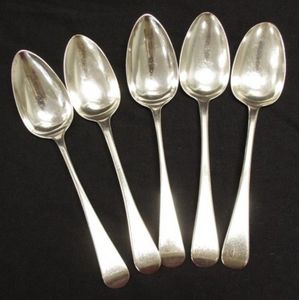Georgian Sterling Silver Soup Spoons, London 1817-1835
You must be a subscriber, and be logged in to view price and dealer details.
Subscribe Now to view actual auction price for this item
When you subscribe, you have the option of setting the currency in which to display prices to $Au, $US, $NZ or Stg.
- Georgian - As an English stylistic period, Georgian is usually taken to cover the period from George I (1714) to the Regency of Prince George (1811-20), although the period from 1800 to 1830 is sometimes designated as the Regency period. During the Georgian period the great English cabinetmakers and designers such as Chippendale, Hepplewhite, Adam Sheraton etc., were all active.
Therefore there isn't a single 'Georgian style' as such and to say something is 'Georgian', usually means it was made between 1714 and 1830. This assumes we discount George V and George VI, both being from the 20th century.
The styles popular at the time of each reign were:
George I (1714-1727) saw out the last years of the Baroque period.
George II (1727-1760) reigned during the Rococo period.
George III (1760-1820) saw the last gasp of the Rococo, all of the early Neo-Classic 'Adam style' and most of the later neo-Classic 'Regency style'.
George IV (Prince Regent 1820-1830)encompassed the last of the 'Regency' style.
William IV's reign (1830-1837) was something of a no man's land (stylistically) and he wasn't a 'George' anyway. He covered the last glimmerings of 'Regency' and the start of the 'Victorian' style. - Sterling Silver - Sterling silver is a mixture of 92.5% pure silver and 7.5% of another metal, usually copper. Fine silver is 99.9% pure silver, and is relatively soft and the addition of the very small amount of copper gives the metal enough strength and hardness to be worked into jewellery, decorative and household objects.
This item has been included into following indexes:
-
spoons, silver
- other, various types and periods 1,209
- soup 187
Visually similar items

A mid 20th century, Royal Netherlands Begeer and van Kempen silver cutlery service, setting for twelve, 1963, comprising a full setting for twelve and accoutrements; 1 x serving spoon, 1 x large spoon, 1 x meat fork, 1 x dessert slice and 1 x dessert servi

Hallmarked sterling silver cutlery consisting of a set of three fiddle pattern forks London, 1836, maker John, Henry and Charles Lias weight 225g pair of fiddle pattern serving spoons monogrammed 'M' London, 1806, maker Richard Crossley weight 145g a set o

Four Victorian & Georgian sterling silver teaspoons fiddle pattern. London, 1827 -1837.

Two pair large antique sterling silver spoons, with old English handle, hallmarked London 1811, and fiddle back handles, hallmarked London 1864, 22 cm long approx, 230 grams approx
